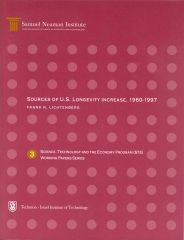Between 1960 and 1997, life expectancy at birth of Americans increased approximately 10%–from 69.7 to 76.5 years—and it has been estimated tha t the value of life extension during this period nearly equaled the gains in tangible consumption. While life expectancy has tended to increase, there have been substantial fluctuations in
the rate of increase. In this paper we investigate whether an aggregate health production function can help to explain the annual time-series behavior of U.S. longevity since 1960. We view longevity as the output of the health production function, and output fluctuations as the consequence of fluctuations in medical inputs (expenditure) and technology.
We estimate longevity models using annual U.S. time-series data on life expectancy, health expenditure, and medical innovation. Reliable annual data are available for only one type of innovation–new drugs but pharmaceutical R&D accounts for a significant fraction of total biomedical research.
The empirical analysis provides strong support for the hypothesis that both medical innovation (in the form of new drug approvals) and expenditure on medical care (especially public expenditure) contributed to longevity increase during the period 1960-1997. Increased drug approvals and health expenditure per person jointly explain just
about 100% of the observed long-run longevity increase.
The estimates provide strong evidence against the null hypothesis that public health expenditure has no effect on longevity, but not against the null hypothesis that private health expenditure has no effect on longevity. This is at least partly attributable to the fact that public health expenditure exhibited much greater variability during the
sample period than private health expenditure.
The estimates imply that the medical expenditure needed to gain one life- year is about $11,000, and that the pharmaceutical R&D expenditure needed to gain one lifeyear is about $1,345. This suggests that increased development of new drugs may be a more cost-effective way of increasing life expectancy than increased medical expenditure in general. Previous researchers have estimated that the average value of a life-year is
approximately $150,000. This figure implies that the benefit-cost ratio of general medical expenditure is 13.6, and that the ratio for pharmaceutical R&D exceeds 100.












